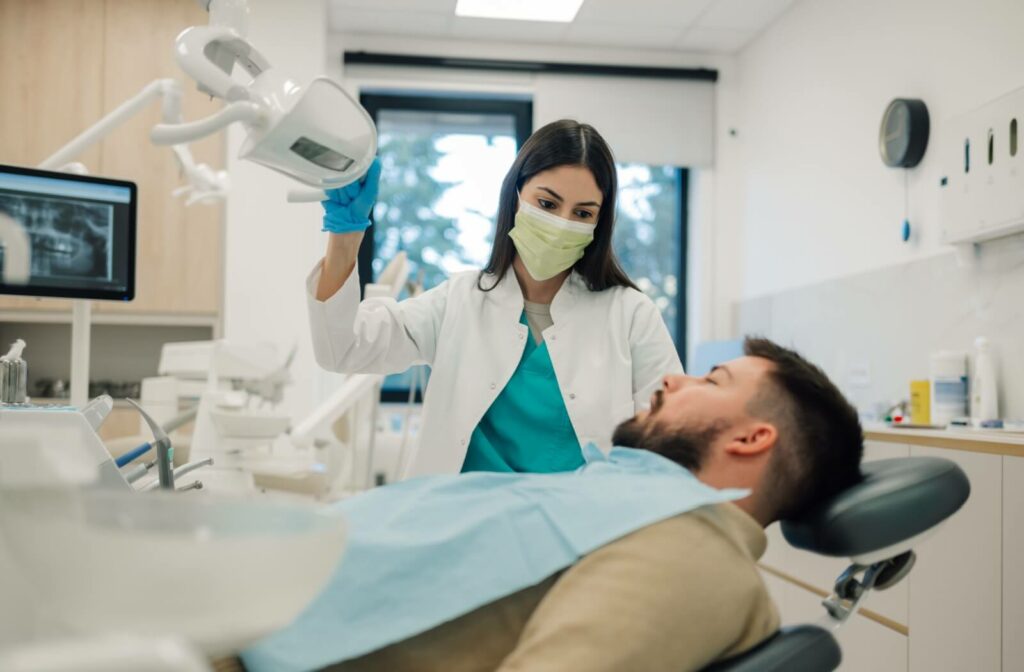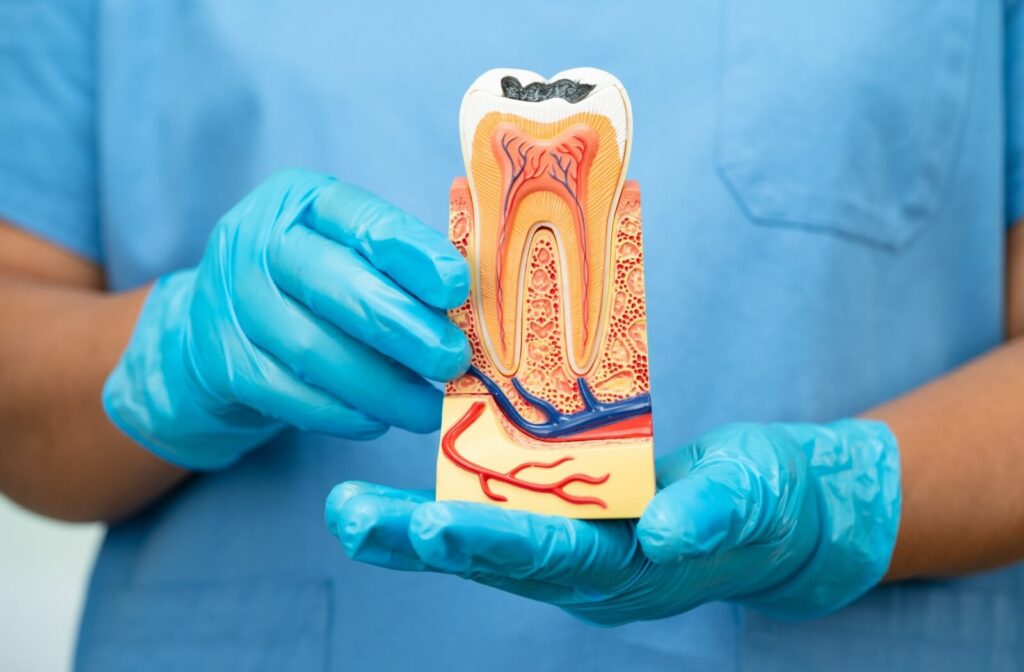When you’re told you need a root canal, it’s natural to feel a little unsure about what to expect, especially when it comes to how long you’ll be in the dental chair.
A typical root canal procedure takes between 30 and 90 minutes, depending on the tooth and the complexity of the case. Some can be completed in one visit, while others may require two.
It’s important to understand the key factors that affect timing, what the procedure involves, and what recovery looks like so you can feel prepared and confident heading into treatment.
What Is a Root Canal?
A root canal is a dental procedure used to treat infection or damage deep within a tooth. Inside every tooth is soft tissue called the pulp, which contains blood vessels and nerves. When the pulp becomes infected (due to decay, trauma, or repeated dental work), it needs to be removed to save the tooth.
During a root canal, your dentist:
- Removes the infected pulp
- Cleans and disinfects the inside of the tooth
- Fills the canals with a biocompatible material
- Seals the tooth to prevent future infection
In most cases, a crown is placed afterward to restore the tooth’s strength and appearance.
What Factors Affect the Length of a Root Canal?
Root canal procedures aren’t one-size-fits-all. Several variables can impact how long the appointment takes.
Location & Type of Tooth
Teeth at the front of the mouth (like incisors and canines) generally have one root, so they tend to be quicker to treat, about 30 to 60 minutes. Molars, located at the back of the mouth, often have two or more roots, making the procedure more complex and time-consuming, sometimes up to 90 minutes.
Severity of the Infection
The more advanced the infection, the longer it may take to ensure all bacteria and damaged tissue are removed. In some cases, the dentist may place medication inside the canals and schedule a second visit to complete the treatment.
Number of Appointments
Some root canals can be done in a single visit, but others require two. A second appointment may be needed if:
- The infection is severe
- A crown is placed later
- The tooth has an unusual anatomy
Is a Root Canal Painful?
Despite its reputation, a root canal is typically no more uncomfortable than getting a regular filling.
During the Procedure
Dentists use local anaesthesia to numb the area completely. You may feel pressure or movement, but you shouldn’t feel pain. If you’re especially anxious, some clinics offer sedation options to help you relax.
After the Procedure
It’s normal to feel mild soreness or tenderness for a few days. Over-the-counter pain relievers like ibuprofen or acetaminophen usually help manage this discomfort. Most patients return to their normal routine the same day.
Eating & Drinking After a Root Canal
Once the freezing wears off, you can eat and drink as usual. However, you’ll want to stick to soft foods and avoid chewing on the treated side until the permanent restoration (often a crown) is placed.
After your root canal, be sure to avoid:
- Crunchy or sticky foods
- Extremely hot or cold beverages
- Hard chewing on the affected tooth
Do You Always Need a Crown After a Root Canal?
Not always, but most teeth that undergo a root canal, especially molars and premolars, benefit from a crown. A crown restores the tooth’s strength and function and helps protect it from cracking.
Front teeth, which are under less pressure when biting, may be restored with a filling instead, depending on how much tooth structure remains.

Root Canal vs. Tooth Extraction
When faced with a damaged or infected tooth, patients often wonder: Why not just pull it?
A root canal can be a better choice because it:
- Preserves your natural tooth
- Helps maintain jaw and bite alignment
- Avoids bone loss and shifting teeth
- Doesn’t require a replacement like a bridge or implant
When Extraction Might Be Necessary
If the tooth is too damaged, cracked below the gum line, or has repeated infections, extraction may be the better option. Your dentist will evaluate the situation and discuss the best course of action with you.
Preparing for a Root Canal
Feeling prepared helps ease nerves and makes the experience smoother. Before your appointment:
- Get a good night’s sleep
- Eat a light meal (unless instructed otherwise)
- Take any prescribed medications
- Let your dentist know if you’re feeling anxious
Aftercare & When to Call Your Dentist
Healing from a root canal is usually quick and straightforward. Most patients resume daily activities within a day. Contact your dentist if you experience:
- Severe or prolonged pain
- Facial swelling
- Fever or signs of infection
- A loose or damaged temporary crown or filling
Prompt follow-up can help avoid complications and ensure proper healing.
Frequently Asked Questions About Root Canals
If you’re preparing for a root canal, you may still have questions about what to expect before, during, and after your procedure. Here are answers to some of the most common concerns patients have.
Can You Drive After a Root Canal?
Yes, most patients can drive themselves home after a root canal if only local anaesthesia is used. However, if sedation is involved, you’ll need someone to drive you home and stay with you for a few hours until the effects wear off.
Can You Eat After a Root Canal?
You can eat once the freezing wears off, but it’s best to start with soft foods and avoid chewing on the treated side. Steer clear of crunchy, sticky, or very hot or cold items until the tooth is fully restored, especially if you have a temporary filling or crown in place.
Root Canal Treatment at Upper Gage Dental Centre
Root canal therapy is a common, safe, and effective way to relieve pain, stop infection, and save your natural tooth. Understanding what the procedure involves and how long it takes can help ease uncertainty and support a smoother experience.
At Upper Gage Dental Centre, we offer comfortable, compassionate root canal treatment tailored to your needs. Our team will guide you through every step, answer your questions, and make sure you feel confident and supported throughout your care.
If you’re dealing with tooth pain or have been told you need a root canal, request an appointment today. We’re here to help you protect your smile and get back to feeling your best.



